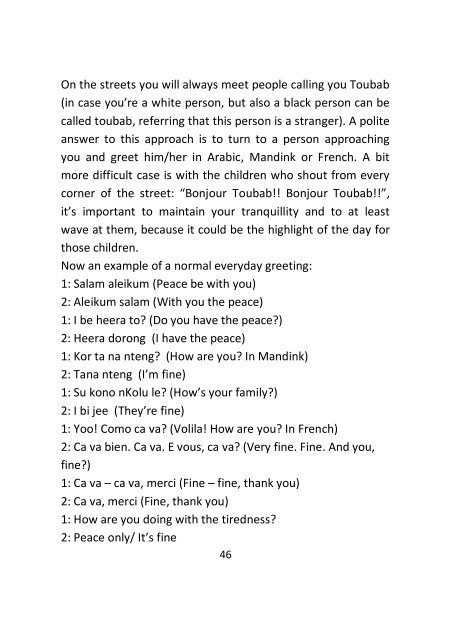GUIDE OF SÉDHIOU - Cesie
GUIDE OF SÉDHIOU - Cesie
GUIDE OF SÉDHIOU - Cesie
Create successful ePaper yourself
Turn your PDF publications into a flip-book with our unique Google optimized e-Paper software.
On the streets you will always meet people calling you Toubab<br />
(in case you’re a white person, but also a black person can be<br />
called toubab, referring that this person is a stranger). A polite<br />
answer to this approach is to turn to a person approaching<br />
you and greet him/her in Arabic, Mandink or French. A bit<br />
more difficult case is with the children who shout from every<br />
corner of the street: “Bonjour Toubab!! Bonjour Toubab!!”,<br />
it’s important to maintain your tranquillity and to at least<br />
wave at them, because it could be the highlight of the day for<br />
those children.<br />
Now an example of a normal everyday greeting:<br />
1: Salam aleikum (Peace be with you)<br />
2: Aleikum salam (With you the peace)<br />
1: I be heera to? (Do you have the peace?)<br />
2: Heera dorong (I have the peace)<br />
1: Kor ta na nteng? (How are you? In Mandink)<br />
2: Tana nteng (I’m fine)<br />
1: Su kono nKolu le? (How’s your family?)<br />
2: I bi jee (They’re fine)<br />
1: Yoo! Como ca va? (Volila! How are you? In French)<br />
2: Ca va bien. Ca va. E vous, ca va? (Very fine. Fine. And you,<br />
fine?)<br />
1: Ca va – ca va, merci (Fine – fine, thank you)<br />
2: Ca va, merci (Fine, thank you)<br />
1: How are you doing with the tiredness?<br />
2: Peace only/ It’s fine<br />
46



